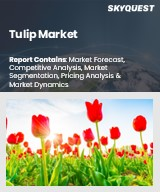
|
시장보고서
상품코드
1530804
세계의 풍력 터빈 시장 예측(-2030년) : 유형별, 설치별, 용량별, 컴포넌트별, 용도별, 최종사용자별, 지역별 분석Wind Turbine Market Forecasts to 2030 - Global Analysis By Type (Horizontal Axis Wind Turbines and Vertical Axis Wind Turbines), Installation, Capacity, Component, Application, End User and By Geography |
||||||
Stratistics MRC에 따르면 세계 풍력 터빈 시장은 2024년 734억 달러로 예측 기간 동안 8.3%의 CAGR로 성장하여 2030년에는 1,185억 달러에 달할 것으로 예상됩니다.
풍력 터빈은 바람의 운동 에너지를 전기 에너지로 변환하기 위해 고안된 장치입니다. 풍력 터빈은 일반적으로 높은 구조물에 설치된 대형 블레이드로 구성되며, 바람이 그 위로 흐르면 블레이드가 회전합니다. 이 회전은 발전기에 연결된 샤프트를 회전시켜 전기를 발생시킵니다. 풍력 터빈은 한 대씩 또는 풍력발전소 내에 설치되며, 집합적으로 전력회사에 전력을 공급합니다. 풍력 터빈은 다양한 풍속에서도 효율적으로 작동하며, 내구성과 에너지 출력에 최적화된 최신 설계가 적용되어 있습니다.
GWEC(세계풍력에너지회의) 통계에 따르면 세계 해상풍력 발전 용량은 2023년 7,500만kW에 달하고, 2023년에는 1,080만kW의 용량이 추가되었습니다.
지원 정책, 세제 혜택, 재생에너지 목표
세액공제, 보조금, 발전차액지원제도와 같은 정부 이니셔티브는 풍력 발전 프로젝트의 재정적 부담을 줄여 투자자와 개발자에게 더욱 매력적으로 만듭니다. 이러한 목표는 공공 부문과 민간 부문 모두에 대한 투자를 장려하는 안정적인 정책 환경을 조성합니다. 자본 비용을 낮추고 풍력 발전소의 투자 수익률을 높이고 시장 성장을 가속화합니다.
높은 자본 지출
풍력 터빈의 구매, 운송 및 설치에 따른 막대한 초기 비용은 특히 신흥 시장이나 소규모 프로젝트의 경우 잠재적 투자자의 발목을 잡을 수 있습니다. 이러한 경제적 장벽은 신규 풍력 발전소 개발을 제한하고 기존 풍력 발전소의 확장을 지연시킬 수 있습니다. 이처럼 높은 설비투자액은 풍력 발전 프로젝트의 재무적 타당성에도 영향을 미쳐 사업자가 자금을 확보하거나 유리한 금융 조건을 실현하는 데 어려움을 겪을 수 있습니다. 이는 투자자의 투자 회수 기간이 길어지고 리스크가 증가하여 시장 성장을 저해하는 요인이 될 수 있습니다.
기후변화에 대한 인식 제고와 온실가스 감축 필요성이 대두
지구 온난화에 대한 사회적, 정부적 관심이 높아짐에 따라 재생에너지에 대한 지지가 높아지고 있으며, 그 중에서도 풍력 발전은 제로 에미션이라는 특성으로 인해 중요한 요소로 떠오르고 있습니다. 이러한 인식의 증가는 재생에너지 의무화, 탄소 가격제, 배출량 감축 목표 등 풍력에너지 채택에 유리한 정책과 규제를 촉진하고 있습니다. 이러한 사회적 변화는 풍력에너지 인프라에 대한 투자와 기술 발전을 촉진하여 풍력 발전의 경쟁력과 접근성을 높이고 있습니다.
기존 에너지 그리드에 풍력 발전의 통합
풍력 발전은 간헐적인 특성을 가지고 있기 때문에 전력망 시스템을 변동하는 전력에 맞게 조정해야 하는데, 이는 상당한 비용과 기술적 문제를 수반합니다. 기존 전력망 인프라는 변동하는 풍력 공급에 대응하기 위해 상당한 업그레이드와 변경이 필요할 수 있으며, 이는 전체 프로젝트의 비용과 복잡성을 증가시킬 수 있습니다. 이러한 문제는 투자를 억제하고 프로젝트 개발을 지연시키며 시장 성장을 저해할 수 있습니다.
COVID-19의 영향:
COVID-19는 공급망에 혼란을 일으켜 제조 및 설치 지연으로 풍력 터빈 시장에 큰 영향을 미쳤습니다. 봉쇄와 여행 제한으로 인해 프로젝트 일정과 인력 확보에 차질이 생겼습니다. 그러나 팬데믹은 또한 탄력적이고 지속가능한 에너지 시스템의 필요성을 강조하고 재생에너지에 대한 관심을 다시 한 번 불러일으켰습니다. 정부와 투자자들은 경제 회복과 기후 변화 목표에 대한 풍력에너지의 중요성을 점점 더 많이 인식하고 있으며, 이는 이 분야에 대한 지속적인 지원과 투자로 이어졌습니다.
예측 기간 동안 수평축 풍력 터빈 부문이 가장 큰 비중을 차지할 것으로 예상
수평축 풍력 터빈은 수평 로터에 장착된 블레이드를 특징으로 하는 설계로 인해 다른 유형에 비해 높은 에너지 회수율과 성능을 달성할 수 있기 때문에 예측 기간 동안 가장 큰 시장이 될 것으로 예상됩니다. 이러한 효율성으로 인해 HAWT는 대규모 풍력 발전 단지에서 선호되는 선택이 되고 있으며, 시장 동향에 큰 영향을 미치고 있어 시장 성장을 촉진하고 있습니다.
로터 블레이드 부문은 예측 기간 동안 가장 높은 CAGR을 기록할 것으로 예상
로터 블레이드 기술의 발전으로 더 크고 효율적인 블레이드가 개발되어 더 많은 풍력에너지를 포착하고 더 많은 전력을 생산할 수 있기 때문에 로터 블레이드 분야는 예측 기간 동안 가장 높은 CAGR을 기록할 것으로 예상됩니다. 긴 블레이드는 터빈의 가동률과 효율을 높이고 다른 에너지 원에 대한 풍력에너지의 경쟁력을 높입니다. 블레이드 재료와 공기역학적 설계의 추가 개선은 운영 및 유지보수 비용 절감에 기여하여 시장의 매력을 더욱 높이고 있습니다.
가장 큰 점유율을 차지하는 지역
북미는 생산세액공제(PTC), 투자세액공제(ITC) 등의 연방 세제 혜택과 주정부 차원의 재생에너지 의무화 및 목표 설정으로 인해 예측 기간 동안 가장 큰 시장 점유율을 차지할 것으로 예상됩니다. 미국에는 다수의 육상 풍력 발전소가 있으며, 해안에서 해상 풍력 발전 프로젝트도 활발히 추진되고 있습니다. 터빈의 대형화, 고효율화 등 기술 발전은 비용 절감과 경쟁력 강화에 기여하고 있습니다.
CAGR이 가장 높은 지역:
아시아태평양은 에너지 수요 증가, 정부 지원 정책, 기후 변화 대응을 위한 재생에너지에 대한 관심 증가로 인해 예측 기간 동안 가장 높은 CAGR을 유지할 것으로 예상됩니다. 중국, 인도, 일본, 한국 등의 국가들이 이러한 성장의 최전선에 있으며, 육상 및 해상 풍력에너지 프로젝트에 많은 투자를 하고 있습니다. 또한, 풍력 터빈 설계, 효율 개선 및 비용 절감에 대한 기술적 진보가 시장 확대를 더욱 가속화하고 있습니다.
무료 커스터마이징 서비스
이 보고서를 구독하는 고객은 다음과 같은 무료 맞춤화 옵션 중 하나를 사용할 수 있습니다.
- 기업 개요
- 추가 시장 기업의 종합적인 프로파일링(최대 3개사까지)
- 주요 기업 SWOT 분석(최대 3개사까지)
- 지역 세분화
- 고객의 관심에 따른 주요 국가별 시장 추정치, 예측, CAGR(주: 타당성 검토에 따른)
- 경쟁사 벤치마킹
- 제품 포트폴리오, 지리적 입지, 전략적 제휴를 기반으로 한 주요 기업 벤치마킹
목차
제1장 주요 요약
제2장 서문
- 개요
- 이해관계자
- 조사 범위
- 조사 방법
- 데이터 마이닝
- 데이터 분석
- 데이터 검증
- 조사 접근법
- 조사 정보 출처
- 1차 조사 정보 출처
- 2차 조사 정보 출처
- 가정
제3장 시장 동향 분석
- 성장 촉진요인
- 성장 억제요인
- 기회
- 위협
- 용도 분석
- 최종사용자 분석
- 신흥 시장
- COVID-19의 영향
제4장 Porter's Five Forces 분석
- 공급 기업의 교섭력
- 구매자의 교섭력
- 대체품의 위협
- 신규 참여업체의 위협
- 경쟁 기업 간의 경쟁 관계
제5장 세계의 풍력 터빈 시장 : 유형별
- 수평축 풍력 터빈
- 수직축 풍력 터빈
제6장 세계의 풍력 터빈 시장 : 설치별
- 온쇼어
- 오프쇼어
제7장 세계의 풍력 터빈 시장 : 용량별
- 1 kW-100kW
- 100 kW-3MW
- 3MW 이상
제8장 세계의 풍력 터빈 시장 : 컴포넌트별
- 터빈
- 로터 블레이드
- 나셀
- 타워
- 기초
- 기타 컴포넌트
제9장 세계의 풍력 터빈 시장 : 용도별
- 유틸리티 스케일
- 상업용
- 주택
제10장 세계의 풍력 터빈 시장 : 최종사용자별
- 정부
- 유틸리티
- 독립 발전 사업자
제11장 세계의 풍력 터빈 시장 : 지역별
- 북미
- 미국
- 캐나다
- 멕시코
- 유럽
- 독일
- 영국
- 이탈리아
- 프랑스
- 스페인
- 기타 유럽
- 아시아태평양
- 일본
- 중국
- 인도
- 호주
- 뉴질랜드
- 한국
- 기타 아시아태평양
- 남미
- 아르헨티나
- 브라질
- 칠레
- 기타 남미
- 중동 및 아프리카
- 사우디아라비아
- 아랍에미리트
- 카타르
- 남아프리카공화국
- 기타 중동 및 아프리카
제12장 주요 발전
- 계약, 파트너십, 협업, 합작투자
- 인수와 합병
- 신제품 발매
- 사업 확대
- 기타 주요 전략
제13장 기업 개요
- Eaton Corporation PLC
- Enercon GmbH
- Gamesa
- General Electric Company
- Goldwind
- Guodian United Power Technology Company Ltd.
- Hitachi Ltd.
- Nordex SE
- Siemens Gamesa Renewable Energy SA
- Suzlon Energy Limited
- Vergnet
- Vestas Wind Systems AS
- Xinjiang Goldwind Science & Technology Co. Ltd
- Zhejiang Windey Co., Ltd.
According to Stratistics MRC, the Global Wind Turbine Market is accounted for $73.4 billion in 2024 and is expected to reach $118.5 billion by 2030 growing at a CAGR of 8.3% during the forecast period. A wind turbine is a device designed to convert the kinetic energy of the wind into electrical energy. It typically consists of large blades mounted on a tall structure, which rotate when wind flows over them. This rotation turns a shaft connected to a generator, producing electricity. Wind turbines can be found individually or grouped together in wind farms, where they collectively generate power for electrical utilities. They operate efficiently at varying wind speeds, with modern designs optimized for durability and energy output.
According to GWEC (Global Wind Energy Council) statistics, the global offshore wind capacity reached 75 GW in 2023, and 10.8 GW of capacity was added in 2023.
Market Dynamics:
Driver:
Supportive policies, tax incentives, and renewable energy targets
Government initiatives, such as tax credits, subsidies, and feed-in tariffs, reduce the financial burden of wind energy projects, making them more attractive to investors and developers. Such targets create a stable policy environment that encourages both public and private sector investments. Lowering the cost of capital and improve the return on investment for wind farms, accelerating market growth.
Restraint:
High capital expenditure
The substantial upfront costs associated with purchasing, transporting, and installing wind turbines can deter potential investors, particularly in emerging markets or for smaller-scale projects. This financial barrier can restrict the development of new wind farms and delay the expansion of existing ones. Thus the high CapEx also affects the financial feasibility of wind projects, making it difficult for developers to secure funding or achieve favorable financing terms. This can lead to longer payback periods and increased risk for investors hampering the growth of the market.
Opportunity:
Growing awareness of climate change and the need to reduce greenhouse gas emissions
As public and governmental concern about global warming intensifies, there is increased support for renewable energy sources, with wind power being a key component due to its zero-emission characteristics. This heightened awareness drives policies and regulations that favor the adoption of wind energy, such as renewable energy mandates, carbon pricing, and emission reduction targets. This societal shift encourages investment in wind energy infrastructure and technological advancements, making wind power more competitive and accessible.
Threat:
Integrating wind power into existing energy grids
The intermittent nature of wind energy requires grid systems to be adapted for variable power inputs, which can involve significant costs and technical challenges. Existing grid infrastructure may need substantial upgrades or modifications to accommodate the fluctuating supply of wind power, increasing the overall project expenses and complexity. These challenges may deter investment and slow down project deployment hinder the market growth.
Covid-19 Impact:
COVID-19 significantly impacted the wind turbine market by disrupting supply chains, causing delays in manufacturing and installation. Lockdowns and travel restrictions hampered project timelines and labor availability. However, the pandemic also highlighted the need for resilient and sustainable energy systems, driving renewed interest in renewable energy sources. Governments and investors increasingly recognized the importance of wind energy for economic recovery and climate goals, leading to continued support and investment in the sector.
The horizontal axis wind turbines segment is expected to be the largest during the forecast period
The horizontal axis wind turbines is expected to be the largest during the forecast period as their design, featuring blades mounted on a horizontal rotor, allows them to achieve higher energy capture and performance compared to other types. This efficiency has made HAWTs the preferred choice for large-scale wind farms and has significantly influenced market trends thus propelling the growth of the market.
The rotor blades segment is expected to have the highest CAGR during the forecast period
The rotor blades segment is expected to have the highest CAGR during the forecast period due to advances in rotor blade technology have led to the development of larger, more efficient blades that can capture more wind energy and generate more power. Longer blades enhance the turbine's capacity factor and efficiency, making wind energy more competitive with other energy sources. Further improved blade materials and aerodynamic designs also contribute to reduced operational and maintenance costs, further boosting market attractiveness
Region with largest share:
North America is projected to hold the largest market share during the forecast period due to federal tax incentives such as the Production Tax Credit (PTC) and Investment Tax Credit (ITC), as well as state-level renewable energy mandates and goals. The U.S. has a large number of onshore wind farms and is increasingly exploring offshore wind projects along its coasts. Technological advancements, including larger and more efficient turbines, have contributed to cost reductions and increased competitiveness.
Region with highest CAGR:
Asia Pacific is projected to hold the highest CAGR over the forecast period owing to increasing energy demand, supportive government policies, and a growing emphasis on renewable energy to combat climate change. Countries such as China, India, Japan, and South Korea are at the forefront of this growth, investing heavily in wind energy projects both onshore and offshore. Moreover Technological advancements in wind turbine design, efficiency improvements, and cost reductions have further accelerated market expansion.
Key players in the market
Some of the key players in Wind Turbine market include Eaton Corporation PLC, Enercon GmbH, Gamesa, General Electric Company, Goldwind, Guodian United Power Technology Company Ltd., Hitachi Ltd., Nordex SE, Siemens, Gamesa Renewable Energy SA, Suzlon Energy Limited, Vergnet, Vestas Wind Systems AS, Xinjiang Goldwind Science & Technology Co. Ltd and Zhejiang Windey Co., Ltd.
Key Developments:
In July 2024, Hitachi High-Tech and National Taiwan University Established a Joint Facility for Electron Microscopes Contributing to the Development of Science and Technology in Taiwan. It also aims for the center to be used for the purpose of disseminating technical information through FIB-SEM.
In July 2024, Siemens and Boson Energy enter agreement to accelerate the green energy transition through waste-to-hydrogen (to-X) technology. The collaboration aims to advance sustainable, local energy security, enabling hydrogen-powered electric vehicle.
In July 2024, Siemens and Stadtwerke Stuttgart partner to spearhead transition to sustainable urban energy. Supports Stuttgart in achieving climate neutral targets, setting example to other cities worldwide in sustainable urban transformation
Types Covered:
- Horizontal Axis Wind Turbines
- Vertical Axis Wind Turbines
Installations Covered:
- Onshore
- Offshore
Capacities Covered:
- 1 kW to 100 kW
- 100 kW to 3 MW
- Above 3 MW
Components Covered:
- Turbine
- Rotor Blades
- Nacelle
- Tower
- Foundation
- Other Components
Applications Covered:
- Utility-Scale
- Commercial
- Residential
End Users Covered:
- Governments
- Utilities
- Independent Power Producers
Regions Covered:
- North America
- US
- Canada
- Mexico
- Europe
- Germany
- UK
- Italy
- France
- Spain
- Rest of Europe
- Asia Pacific
- Japan
- China
- India
- Australia
- New Zealand
- South Korea
- Rest of Asia Pacific
- South America
- Argentina
- Brazil
- Chile
- Rest of South America
- Middle East & Africa
- Saudi Arabia
- UAE
- Qatar
- South Africa
- Rest of Middle East & Africa
What our report offers:
- Market share assessments for the regional and country-level segments
- Strategic recommendations for the new entrants
- Covers Market data for the years 2022, 2023, 2024, 2026, and 2030
- Market Trends (Drivers, Constraints, Opportunities, Threats, Challenges, Investment Opportunities, and recommendations)
- Strategic recommendations in key business segments based on the market estimations
- Competitive landscaping mapping the key common trends
- Company profiling with detailed strategies, financials, and recent developments
- Supply chain trends mapping the latest technological advancements
Free Customization Offerings:
All the customers of this report will be entitled to receive one of the following free customization options:
- Company Profiling
- Comprehensive profiling of additional market players (up to 3)
- SWOT Analysis of key players (up to 3)
- Regional Segmentation
- Market estimations, Forecasts and CAGR of any prominent country as per the client's interest (Note: Depends on feasibility check)
- Competitive Benchmarking
- Benchmarking of key players based on product portfolio, geographical presence, and strategic alliances
Table of Contents
1 Executive Summary
2 Preface
- 2.1 Abstract
- 2.2 Stake Holders
- 2.3 Research Scope
- 2.4 Research Methodology
- 2.4.1 Data Mining
- 2.4.2 Data Analysis
- 2.4.3 Data Validation
- 2.4.4 Research Approach
- 2.5 Research Sources
- 2.5.1 Primary Research Sources
- 2.5.2 Secondary Research Sources
- 2.5.3 Assumptions
3 Market Trend Analysis
- 3.1 Introduction
- 3.2 Drivers
- 3.3 Restraints
- 3.4 Opportunities
- 3.5 Threats
- 3.6 Application Analysis
- 3.7 End User Analysis
- 3.8 Emerging Markets
- 3.9 Impact of Covid-19
4 Porters Five Force Analysis
- 4.1 Bargaining power of suppliers
- 4.2 Bargaining power of buyers
- 4.3 Threat of substitutes
- 4.4 Threat of new entrants
- 4.5 Competitive rivalry
5 Global Wind Turbine Market, By Type
- 5.1 Introduction
- 5.2 Horizontal Axis Wind Turbines
- 5.3 Vertical Axis Wind Turbines
6 Global Wind Turbine Market, By Installation
- 6.1 Introduction
- 6.2 Onshore
- 6.3 Offshore
7 Global Wind Turbine Market, By Capacity
- 7.1 Introduction
- 7.2 1 kW to 100 kW
- 7.3 100 kW to 3 MW
- 7.4 Above 3 MW
8 Global Wind Turbine Market, By Component
- 8.1 Introduction
- 8.2 Turbine
- 8.3 Rotor Blades
- 8.4 Nacelle
- 8.5 Tower
- 8.6 Foundation
- 8.7 Other Components
9 Global Wind Turbine Market, By Application
- 9.1 Introduction
- 9.2 Utility-Scale
- 9.3 Commercial
- 9.4 Residential
10 Global Wind Turbine Market, By End User
- 10.1 Introduction
- 10.2 Governments
- 10.3 Utilities
- 10.4 Independent Power Producers
11 Global Wind Turbine Market, By Geography
- 11.1 Introduction
- 11.2 North America
- 11.2.1 US
- 11.2.2 Canada
- 11.2.3 Mexico
- 11.3 Europe
- 11.3.1 Germany
- 11.3.2 UK
- 11.3.3 Italy
- 11.3.4 France
- 11.3.5 Spain
- 11.3.6 Rest of Europe
- 11.4 Asia Pacific
- 11.4.1 Japan
- 11.4.2 China
- 11.4.3 India
- 11.4.4 Australia
- 11.4.5 New Zealand
- 11.4.6 South Korea
- 11.4.7 Rest of Asia Pacific
- 11.5 South America
- 11.5.1 Argentina
- 11.5.2 Brazil
- 11.5.3 Chile
- 11.5.4 Rest of South America
- 11.6 Middle East & Africa
- 11.6.1 Saudi Arabia
- 11.6.2 UAE
- 11.6.3 Qatar
- 11.6.4 South Africa
- 11.6.5 Rest of Middle East & Africa
12 Key Developments
- 12.1 Agreements, Partnerships, Collaborations and Joint Ventures
- 12.2 Acquisitions & Mergers
- 12.3 New Product Launch
- 12.4 Expansions
- 12.5 Other Key Strategies
13 Company Profiling
- 13.1 Eaton Corporation PLC
- 13.2 Enercon GmbH
- 13.3 Gamesa
- 13.4 General Electric Company
- 13.5 Goldwind
- 13.6 Guodian United Power Technology Company Ltd.
- 13.7 Hitachi Ltd.
- 13.8 Nordex SE
- 13.9 Siemens Gamesa Renewable Energy SA
- 13.10 Suzlon Energy Limited
- 13.11 Vergnet
- 13.12 Vestas Wind Systems AS
- 13.13 Xinjiang Goldwind Science & Technology Co. Ltd
- 13.14 Zhejiang Windey Co., Ltd.



















